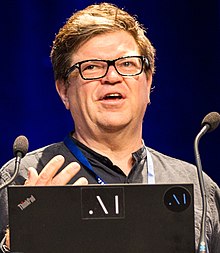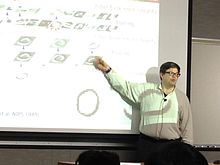杨立昆
| 杨立昆 Yann LeCun | |
|---|---|
 摄于2018年 | |
| 出生 | 1960年7月8日 |
| 母校 | 巴黎电子工程师高等学校(Diplôme d'Ingénieur) 巴黎第六大学(PhD) |
| 知名于 | 深度学习 |
| 奖项 | 图灵奖(2018) 美国人工智能协会会士(2018) 法国荣誉军团勋章(2020) |
| 网站 | yann |
| 科学生涯 | |
| 机构 | 贝尔实验室 纽约大学 Meta |
| 论文 | Modèles connexionnistes de l'apprentissage(1987年) |
| 博士导师 | 莫里斯·米尔格拉姆(Maurice Milgram) |

杨立昆(法语:Yann André LeCun,发音:[jan ɑ̃dʁe ləkœ̃];1960年7月8日—),本名扬·安德烈·勒坎,是法国计算机科学家,2018年图灵奖得主,他在机器学习、计算机视觉、移动机器人和计算神经科学等领域都有很多贡献。他最著名的工作是在光学字符识别和计算机视觉上使用卷积神经网络,他也被称为卷积网络之父。[1][2]他同莱昂·博图和帕特里克·哈夫纳(Patrick Haffner)等人创建了DjVu图像压缩技术。他同莱昂·博图开发了Lush语言。2019年他同约书亚·本希奥以及杰弗里·辛顿共同获得计算机学界最高奖项图灵奖。
生平
[编辑]杨立昆于1960年生于法国巴黎附近,1983年在巴黎电子工程师高等学校获得了工程师学位(Diplôme d'Ingénieur),1987年在巴黎第六大学获得计算机科学博士学位。博士就读期间,他提出了神经网络的反向传播算法学习算法的原型。[3]随后到多伦多大学在杰弗里·辛顿的指导下完成了博士后工作。
1988年,杨立昆加入位于美国新泽西州的霍姆德尔镇区的贝尔实验室的自适应系统研究部门。实验室的领导是Lawrence D. Jackel,在此,他开发了很多新的机器学习方法,比如图像识别的模型称为卷积神经网络,[4]"Optimal Brain Damage" regularization methods,[5]以及Graph Transformer Networks方法(类似于条件随机域),他将其应用到手写识别和光学字符识别(OCR)中。[6]
他协助开发的银行支票识别系统被NCR和其他的公司广泛使用,该系统读取了20世纪90年代末至21世纪初全美国超过10%的支票。
1996年,他加入了AT&T实验室,成为图像处理研究部门的领导,这个部门是Lawrence Rabiner领导的语音和图像处理研究实验室的一部分,主要工作是DjVu图像压缩技术,[7]被以互联网档案馆为首的网站使用,用来发布扫描的文档。他的AT&T同事包括Léon Bottou和弗拉基米尔·瓦普尼克。
After a brief tenure as a Fellow of the NEC Research Institute (now NEC-Labs America) in 普林斯顿, he joined 纽约大学 (NYU) in 2003, where he is Silver Professor of Computer Science Neural Science at the 科朗数学研究所 and the Center for Neural Science. He is also a professor at the 纽约大学坦登工程学院.[8][9] At NYU, he has worked primarily on Energy-Based Models for supervised and unsupervised learning,[10] feature learning for object recognition in 计算机视觉,[11] and mobile robotics.[12]
2012年,他成为了纽约大学数据科学中心的创建主任。[13] 2013年12月9日,杨立昆成为位于纽约的Facebook人工智能研究院的第一任主任,[14]2014年初期逐步退出了NYU-CDS的领导层。
杨立昆获得了2014 IEEE Neural Network Pioneer Award和2015 PAMI Distinguished Researcher Award。
在2013年,他和约书亚·本希奥一起创建了International Conference on Learning Representations, which adopted a post-publication open review process he previously advocated on his website. He was the chair and organizer of the "Learning Workshop" held every year between 1986 and 2012 in Snowbird, Utah. He is a member of the Science Advisory Board of the Institute for Pure and Applied Mathematics[15] at 加州大学洛杉矶分校, and has been on the advisory board of a number of companies, including MuseAmi, KXEN Inc., and Vidient Systems.[16] He is the Co-Director of the Neural Computation & Adaptive Perception research program of CIFAR[17]
在2016年,他在巴黎法兰西公学院的"Chaire Annuelle Informatique et Sciences Numériques"做访问教授。His "leçon inaugurale" (inaugural lecture) has been an important event in 2016 Paris intellectual life.
姓名
[编辑]杨立昆的原来中文译名为:扬·勒丘恩,2017年他在中国的演讲提供了正式的中文姓名[18]。他法文的姓是(Le Cun),到美国之后,很多人都误认为Le是中间名,所以他在20世纪八九十年代把自己的姓的拼法改成了LeCun。[19][20]
参考
[编辑]- ^ Convolutional Nets and CIFAR-10: An Interview with Yann LeCun.. [2016-08-31]. (原始内容存档于2015-12-22).
- ^ LeCun, Yann; Bottou, Léon; Bengio, Yoshua; Haffner, Patrick. Gradient-based learning applied to document recognition (PDF). Proceedings of the IEEE. 1998, 86 (11): 2278–2324 [2013-11-16]. doi:10.1109/5.726791. (原始内容存档 (PDF)于2021-07-03).
- ^ Y. LeCun: Une procédure d'apprentissage pour réseau a seuil asymmetrique (a Learning Scheme for Asymmetric Threshold Networks), Proceedings of Cognitiva 85, 599–604, Paris, France, 1985.
- ^ Y. LeCun, B. Boser, J. S. Denker, D. Henderson, R. E. Howard, W. Hubbard and L. D. Jackel: Backpropagation Applied to Handwritten Zip Code Recognition, Neural Computation, 1(4):541-551, Winter 1989.
- ^ Yann LeCun, J. S. Denker, S. Solla, R. E. Howard and L. D. Jackel: Optimal Brain Damage, in Touretzky, David (Eds), Advances in Neural Information Processing Systems 2 (NIPS*89), Morgan Kaufmann, Denver, CO, 1990.
- ^ Yann LeCun, Léon Bottou, Yoshua Bengio and Patrick Haffner: Gradient Based Learning Applied to Document Recognition, Proceedings of IEEE, 86(11):2278–2324, 1998.
- ^ Léon Bottou, Patrick Haffner, Paul G. Howard, Patrice Simard, Yoshua Bengio and Yann LeCun: High Quality Document Image Compression with DjVu, Journal of Electronic Imaging, 7(3):410–425, 1998.
- ^ People - Electrical and Computer Engineering. Polytechnic Institute of New York University. [2013-03-13]. (原始内容存档于2013-12-05).
- ^ 存档副本. [2016-08-31]. (原始内容存档于2017-04-01).
- ^ Yann LeCun, Sumit Chopra, Raia Hadsell, Ranzato Marc'Aurelio and Fu-Jie Huang: A Tutorial on Energy-Based Learning, in Bakir, G. and Hofman, T. and Schölkopf, B. and Smola, A. and Taskar, B. (Eds), Predicting Structured Data, MIT Press, 2006.
- ^ Kevin Jarrett, Koray Kavukcuoglu, Marc'Aurelio Ranzato and Yann LeCun: What is the Best Multi-Stage Architecture for Object Recognition?, Proc.
- ^ Raia Hadsell, Pierre Sermanet, Marco Scoffier, Ayse Erkan, Koray Kavackuoglu, Urs Muller and Yann LeCun: Learning Long-Range Vision for Autonomous Off-Road Driving, Journal of Field Robotics, 26(2):120–144, February 2009.
- ^ 存档副本. [2021-12-29]. (原始内容存档于2013-05-11).
- ^ 存档副本. [2016-08-31]. (原始内容存档于2021-02-24).
- ^ http://www.ipam.ucla.edu/programs/gss2012/ (页面存档备份,存于互联网档案馆) Institute for Pure and Applied Mathematics
- ^ Vidient Systems (页面存档备份,存于互联网档案馆).
- ^ Neural Computation & Adaptive Perception Advisory Committee Yann LeCun. CIFAR. [16 December 2013]. (原始内容存档于2016-04-08).
- ^ Yann LeCun清华演讲. 36kr. 36氪. 2017-03-23 [2021-05-31]. (原始内容存档于2021-06-02) (中文).
- ^ No, Your Name can't possibly be pronounced that way (页面存档备份,存于互联网档案馆).
- ^ La leçon d’un maître de l’intelligence artificielle au Collège de France. Le Monde.fr (世界报). 2016-02-04 [2021-05-31]. (原始内容存档于2021-11-03) (法语).
外部链接
[编辑]- 杨立昆的个人网页 (页面存档备份,存于互联网档案馆)
- 杨立昆在NYU的实验室网页 (页面存档备份,存于互联网档案馆)
- 杨立昆在Collége de France的网页 (页面存档备份,存于互联网档案馆)
- 杨立昆的博士学生名单[永久失效链接]
- 杨立昆发表的文章 (页面存档备份,存于互联网档案馆)
- Convolutional Neural Networks (页面存档备份,存于互联网档案馆)
- DjVuLibre website (页面存档备份,存于互联网档案馆)
- Lush website (页面存档备份,存于互联网档案馆)
- AMA: Yann LeCun (self.MachineLearning) (页面存档备份,存于互联网档案馆) www.reddit.com Ask Me Anything : Yann LeCun
- IEEE Spectrum Article (页面存档备份,存于互联网档案馆)
- Technology Review article (页面存档备份,存于互联网档案馆)
